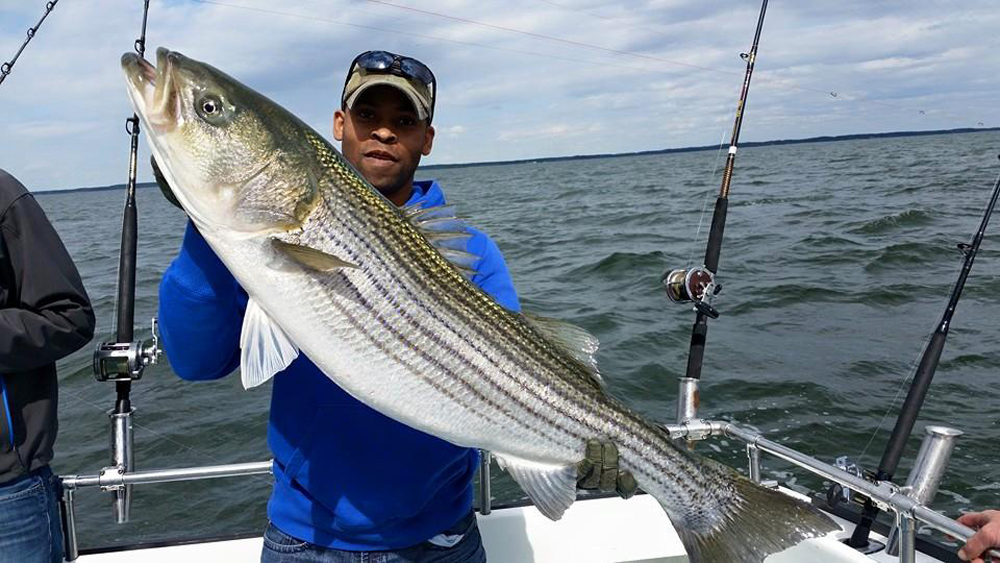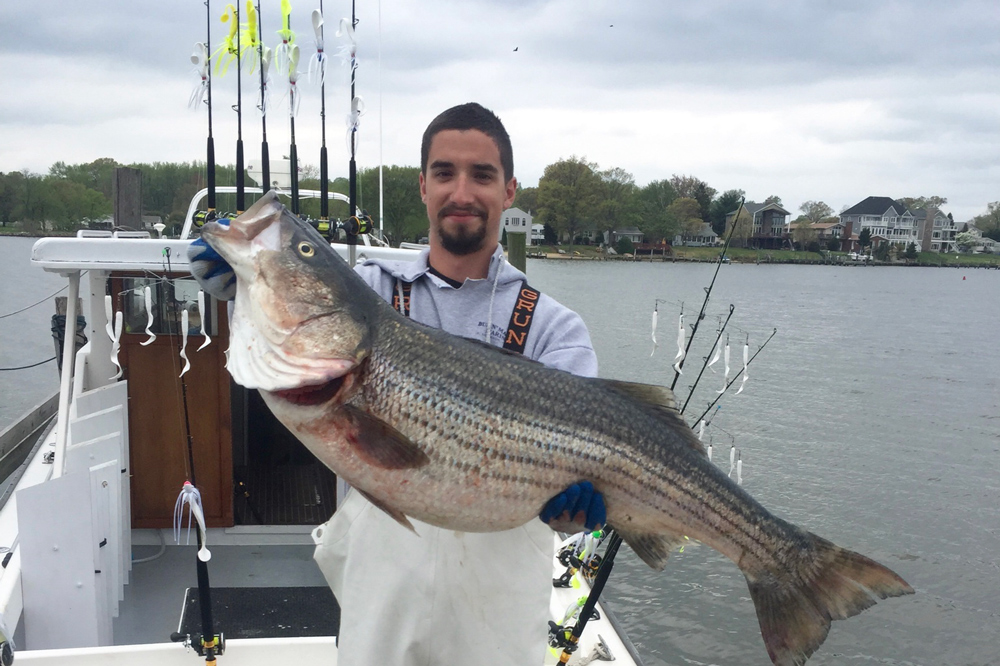You’ve re-spooled the reels, combed out the parachutes, taken the boat for its shake-down cruise, and as you read this right now your hands are probably shaking with anticipation of the fact that one of the most popular Chesapeake Bay fishing experiences, spring trophy rockfish trolling, is finally about to begin. This short window of opportunity provides you with your best shot at catching a monster rockfish, and trolling is generally considered the most effective method to do so – but only if you have all your ducks in a row, and a solid game-plan mapped out.

To help everyone hitting the water have more success this year we talked to one of the experts in the field, Captain Brian Mayer of Marauder Charters fishing out of Solomons, MD, and asked him to share some tips and tricks.
1. Be Precise – Speak with Mayer for a matter of minutes, and it quickly becomes clear that his scientific training in biology and marine science has a huge impact on the way he fishes. Taking the guesswork out of trolling is one of his imperatives.
“Every rod has a place, and every measurement counts,” Mayer says. “Think of it like using scientific method, to eliminate all the variables.”
One of the clearest examples he uses is setting your trolling spread to cover the water column. “Many people aren’t catching fish because all their lures are in the same place,” he explains. “We run 18 to 25 lines and every one of them has a specific place I want them to be. All of our heads are either two, four, or six ounces. I eliminated all the oddballs, because having lures run at unknown depths and positions simply doesn’t help. If I’m trolling and I get a bite on a line running 60 feet off a planer board, I can run other lines with the exact same amount of cumulative weight at the exact same distance and target the exact depth range.”
2. Be Consistent – Mayer says he measures the distance from the rod tip to the lead swivel, and from the swivel to the lures. “What that exact distance may be isn’t the most important thing,” he says. “What really counts is just that it’s the same for each and every rig on your boat. I know some people who like shorter leaders, and others who like longer leaders. Fine. But don’t mix them up, or you don’t have the consistency you need.”
Think back to the prior example of a fish striking a line running 60 feet off the planer board. If some of your rigs have five-foot leaders and others have 15-foot leaders, you just threw the whole equation out of whack – and you can’t capitalize on what you learned when you got that bite.
3. Troll Perpendicular to the Current – Mayer encourages anglers to look at this part of trolling from a biological standpoint. “Fish usually swim with the current or against it,” he explains, “so they’re facing in one of those two directions. The idea is to troll your lures past the fish in such a way that the fish sees the lure, right? That means pulling the lure across the direction the fish is facing, not running parallel to it.”
4. Keep Your Baits Clean – Most Chesapeake trollers have dealt with the scourge of winter jellies at one time or another, and Mayer feels it’s imperative to keep your baits clean of them – as well as keeping them clean or seaweed, mud, or anything else. He says that all of the lures on his boat get checked each and every hour. And at the end of the day, they all get washed, combed, and cleaned prior to being hung up for the night.
5. Use a Speedometer Independent of Your GPS – “Don’t even worry about GPS speed, what counts is speed through the water,” he explains. “Here in the Chesapeake we have so many weird currents and eddies, at any given time you might have as much as two knots of difference between your GPS speed and a separate paddlewheel speedometer. It’s the boat’s physical speed through the water – not what some satellite says – that matters.”
6. For Marking, use Jerry Brown – Yellow Jerry Brown Spectra 200-pound test is the hands-down best for marking your lines, in Mayer’s experience. “I put in a five- to six-foot section,” he says, “splicing it in with an Albright knot. It doesn’t damage anything, it doesn’t get in the way, and it helps you know exactly where your baits are so you can make the adjustments you need to make without guesswork.”
Armed with these tips, will you set the world on fire with your spring trophy spread? Maybe, or maybe not. A lot depends on the weather, your experience level, whether or not the fish pull an early disappearing act, as they did last season, and of course luck. Mayer’s own 2017 trophy season was, however, quit telling when one considers how effective his advice may or may not be.
“It wasn’t the best season ever,” he notes, “but it wasn’t horrible, either. We still caught our fish.” The reason? Precise consistency.

TIP: The preferred trolling speed: between 2.8 and 3.1 knots.
TIP: Although Mayer recognizes that other colors do work at times, he says he sticks with chartreuse and white. But he doesn’t worry about mixing and matching the two between different heads and tails, which he feels works just fine.
TIP: Outside planer lines get set to 80 feet, and inside lines go to 60 feet.
TIP: Mainlines are 80-pound PowerPro braid.
TIP: Leaders are made with 80-pound test Jinkai monofilament. Remember: the specific length isn’t as important as making sure that all your leaders are consistently the same length.
- Capt. Brian Mayer not only charters the Marauder, but can also be hired to join you on your own boat for a day of educational fishing. If you’d like to book the Marauder or have him come aboard to help you iron out the wrinkles in your own system, call (240) 417-2408 or go to Marauder Charters.